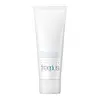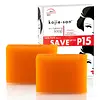What's inside
What's inside
 Key Ingredients
Key Ingredients

 Benefits
Benefits

 Concerns
Concerns

 Ingredients Side-by-side
Ingredients Side-by-side

Glycerin
HumectantPotassium Cocoyl Glycinate
Water
Skin ConditioningButylene Glycol
HumectantPolyglyceryl-10 Myristate
Skin ConditioningDisodium Lauryl Sulfosuccinate
CleansingGlyceryl Stearate
EmollientCitric Acid
BufferingNiacinamide
SmoothingTuna Extract
Skin ConditioningCnidium Officinale Rhizome Extract
Skin ConditioningCapsicum Annuum Fruit Extract
AntimicrobialDipotassium Glycyrrhizate
HumectantPisum Sativum Extract
Skin ConditioningTriticum Vulgare Germ Extract
Skin ConditioningGlycerin, Potassium Cocoyl Glycinate, Water, Butylene Glycol, Polyglyceryl-10 Myristate, Disodium Lauryl Sulfosuccinate, Glyceryl Stearate, Citric Acid, Niacinamide, Tuna Extract, Cnidium Officinale Rhizome Extract, Capsicum Annuum Fruit Extract, Dipotassium Glycyrrhizate, Pisum Sativum Extract, Triticum Vulgare Germ Extract
Cocos Nucifera Oil
MaskingWater
Skin ConditioningSodium Hydroxide
BufferingParfum
MaskingKojic Acid
AntioxidantGlycerin
HumectantXanthan Gum
EmulsifyingCaprylyl Glycol
EmollientGlucose
HumectantChondrus Crispus
MaskingPhenoxyethanol
PreservativeEthylhexylglycerin
Skin ConditioningCocamide DEA
EmulsifyingParaffinum Liquidum
EmollientMelaleuca Alternifolia Leaf Oil
AntioxidantCI 15985
Cosmetic ColorantCI 19140
Cosmetic ColorantBHT
Antioxidant
 Reviews
Reviews

Ingredients Explained
These ingredients are found in both products.
Ingredients higher up in an ingredient list are typically present in a larger amount.
Glycerin is already naturally found in your skin. It helps moisturize and protect your skin.
A study from 2016 found glycerin to be more effective as a humectant than AHAs and hyaluronic acid.
As a humectant, it helps the skin stay hydrated by pulling moisture to your skin. The low molecular weight of glycerin allows it to pull moisture into the deeper layers of your skin.
Hydrated skin improves your skin barrier; Your skin barrier helps protect against irritants and bacteria.
Glycerin has also been found to have antimicrobial and antiviral properties. Due to these properties, glycerin is often used in wound and burn treatments.
In cosmetics, glycerin is usually derived from plants such as soybean or palm. However, it can also be sourced from animals, such as tallow or animal fat.
This ingredient is organic, colorless, odorless, and non-toxic.
Glycerin is the name for this ingredient in American English. British English uses Glycerol/Glycerine.
Learn more about GlycerinWater. It's the most common cosmetic ingredient of all. You'll usually see it at the top of ingredient lists, meaning that it makes up the largest part of the product.
So why is it so popular? Water most often acts as a solvent - this means that it helps dissolve other ingredients into the formulation.
You'll also recognize water as that liquid we all need to stay alive. If you see this, drink a glass of water. Stay hydrated!
Learn more about Water